 |
PO Box 9021,
Wilmington, DE 19809, USA
E-mail: font@focusonnature.com
Phone: Toll-free in USA 1-888-721-3555
or 302/529-1876 |
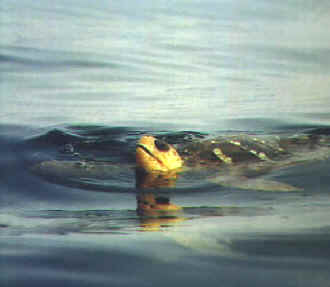 Amphibians
and Reptiles
Amphibians
and Reptiles
of North Carolina
Noting those during Focus On Nature Tours
with an (*)
including:
Salamanders
Toads & Frogs (seen or heard)
Turtles
Skinks, Anoles, and other Lizards
Snakes
A list compiled by Armas Hill
(with input by the staff from the
Howell Woods Environmental Learning Center
in Four Oaks, North Carolina)
UPPER RIGHT PHOTO: a LOGGERHEAD SEA TURTLE photographed off the North Carolina
seacoast
(Photo by Alan Brady)
Codes:
ARR: area of Alligator River National
Wildlife Refuge
CNF: areas of Croatan National Forest & nearby coastal North Carolina
NRV: (upper) Neuse River Valley (the Piedmont)
OBX: Outer Banks (including Roanoke Island & Ocracoke Island)
Species classified as GLOBALLY THREATENED:
(t1): critically threatened
(t2): endangered
(t3): vulnerable
(nt): a near-threatened species globally
(ph): species with a photo in the FONT website
Excellent recordings of the sounds of frogs and toads are in the audio CD of "The
Calls of Frogs and Toads", by Lang Elliot, 2004.
In this list, numbers noted as (LE:xx) refer to
that of the particular frog or toad in the CD. Recordings in the disk
referred to here were by Lang Elliot,
Links to
Groupings in this List:
AMPHIBIANS:
Frogs &
Toads Salamanders
REPTILES: Alligator
Turtles Lizards
Snakes
More about AMPHIBIANS & REPTILES in this list in:
Amphibians & Reptiles in Eastern North America
Other Links:
Upcoming FONT Birding & Nature Tours in North Carolina
Upcoming FONT Tours Elsewhere
FONT Past Tour Highlights
Photo Galleries & Narratives
from past FONT tours
Birds during
FONT North Carolina Tours (with some photos)
Mammals in North Carolina (with some photos)
Butterflies,
Moths, Dragonflies, & Damselflies in North
Carolina (with some photos)
Wildflowers & Other Plants of Eastern North America, inc. North Carolina
Other Photo Galleries & Lists of Amphibians & Reptiles
Directory of Photos in this Website

Amphibians:
Frogs
& Toads
Family RANIDAE: TRUE
FROGS
- Green Frog (ph) ______ (*) NRV
(LE:3) Size: grows up to 2 to 3.5 inches
Rana clamitans
The Green Frog is primarily aquatic in its habits. It can be abundant,
occurring along the edges of ponds, lakes, streams, and other permanent
bodies of water.
When approached, the Green Frog leaps from the shoreline and squeaks an
alarm note before hitting the water.
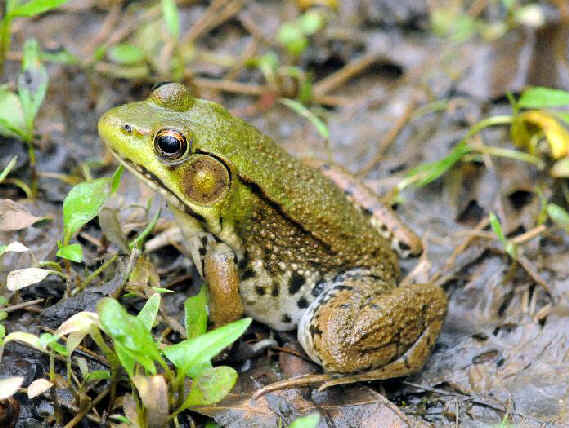
Above & below: Green Frogs
(upper photo by Howard Eskin, lower photo by Marie
Gardner)
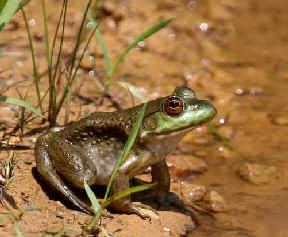
Below: a tadpole of the Green Frog (photo by Marie Gardner)
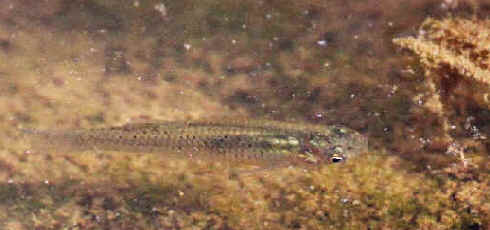
- American Bullfrog (ph) ______ (*) ARR,NRV
(LE:1) Size: 3 to 8 inches
Rana catesbeiana
The coloration and pattern of the American Bullfrog is
variable.
The dorsal color varies from bright leaf green to olive, olive-brown,
or brown.
The dorsal pattern varies with individuals that may include mottling
or marbles that are dark brown to black on the back and the sides of the
body.
The American Bullfrog may be heard, generally, from April to August.
It avoids temporary bodies of water.
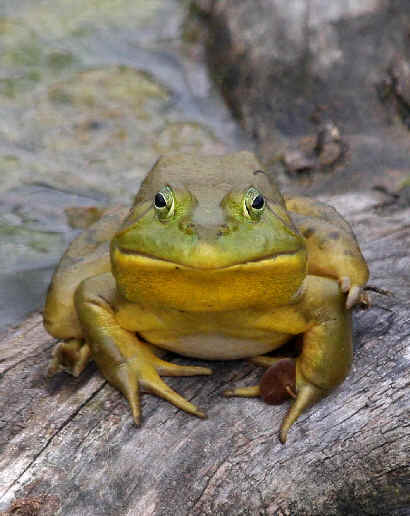
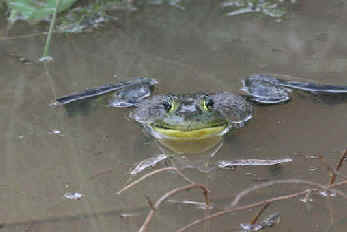
Two photographs of Bullfrogs
(upper photo courtesy of Doris Potter;
lower photo during a FONT tour)
- River Frog ______
(LE:14) occurs in
southern North Carolina Size: 3 to 5.25or 6 inches
Rana heckscheri
The River Frog occurs in the coastal plain. It is generally
uncommon.
Unlike the Carolina Gopher Frog (below, in this list), the River
Frog generally does not call in choruses, and the calls of lone males (a
low, rumbling snore lasting from 1 to 3 seconds) are easily overlooked.
The breeding of Rana heckscheri
is from April through the summer.
- Pickerel Frog (ph) ______ (*) ARR,NRV
(LE:11) Size: 1.25 to 3.5 inches
Rana palustris
The Pickerel Frog breeds in lakes, ponds, and streams. It also
occurs in grassy areas away from water.
Males sometimes call while submerged.
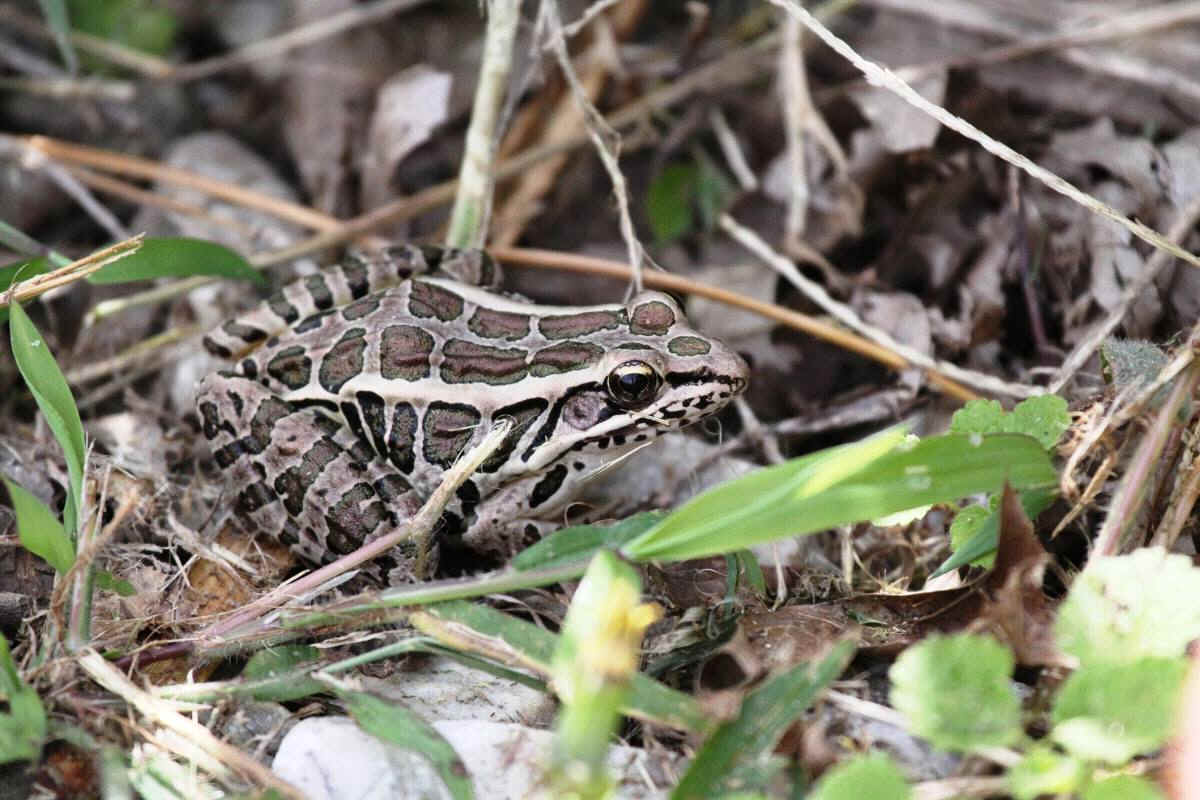
Pickerel Frog
(photo
by Marie Gardner)
- Carpenter Frog ______ (*) ARR
(LE:6) in eastern and southern North Carolina
Size: 1.5 to
2.5 inches
Rana virgatipes
The name "Carpenter Frog" is because its advertisement call is a
distinctive series of sharp, double rapping notes, that sound like two
carpenters hammering nails slightly out of synch. It may be heard from
spring to late summer.
Rana virgatipes
is also called the Sphagum Frog due to its close association
with sphagum bogs.
Otherwise, it can also be found at lakes and ponds.
- Southern Leopard Frog ______
(*) ARR (LE:9) Size
generally 2 to 3.5 inches, but can be up to 5 inches in length
Rana sphenocephala
The Southern Leopard Frog often wanders away from water into grassy and
weedy places. It may be heard in the spring and, in the southern part of its
range, throughout the year.
- Carolina Gopher Frog ______
(LE:12) Size: up to 4 inches long
Rana capito
Rana capito
is found in dry, sandy habitats of the coastal plain. It breeds in
nearby ponds and swamps.
It is a nocturnal species, that is named for its habit of taking shelter
during the day in burrows of other animals, particularly the Gopher
Tortoise (which occurs in southern South Carolina and south to
Florida).
- Wood Frog ______ (LE:4)
in
western North Carolina Size: 1.5 to 3.25 inches
Rana sylvatica
Outside it breeding season, the Wood Frog is terrestrial,
preferring moist, wooded areas.
- Crawfish Frog ______ (*) CNF
(LE:13) Size: 2.75 to 3.5 inches
Rana areolata
The Crawfish Frog favors moist pastures and meadows, where it
takes shelter during the day in crawfish burrows, or the burrows of other
animals.
The northern limit of the range of the Crawfish Frog is east-central
North Carolina.
In North Carolina, Rana areolata
is classified as near, or potentially, threatened.
- Southern Chorus Frog ______ (*) CNF
(LE:28)
size: 0.75 to 1.25 inches
Pseudacris nigrita nigrita
The range of the Southern Chorus Frog, Pseudacris
nigrita, is the coastal plain from North Carolina to
Mississippi.
The northern limit of is range is east-central North Carolina. It frequents
a variety of habitats.
Pseudacris nigrita calls from
grass at the edge of water in roadside ditches, temporary pools, and flooded
fields.
The Southern Chorus Frog breeds in the winter, from November to
April.
- Upland Chorus Frog ______
(LE:27) Size: 0.75 to 1.5 inches
Pseudacris feriarum
The Upland Chorus Frog, now Pseudacris
feriarum, was long considered to be a subspecies of the Western
Chorus Frog, or Striped Chorus Frog,
Pseudacris triseriata.
In the eastern US, the Upland Chorus Frog is generally restricted to
the Piedmont region.
Pseudacris feriarum breeds from
winter to spring in roadside ditches and other shallow water, often adjacent
to farmland.
- Mountain Chorus Frog ______
(LE:30) Size: 1 to 1.5 inches
Pseudacris brachyphona
The Mountain Chorus Frog ranges in the Appalachian Mountains,
south from southwestern Pennsylvania.
In North Carolina, it is in the far-western part of the state.
Pseudacris brachyphona breeds
from winter to spring in pools, ditches, pongs, or springs in forests or at
forest edges.
- Brimley's Chorus Frog ______
(LE:29) Size: 1 to 1.25 inches
Pseudacris brimleyi
The range of the Brimley's Chorus Frog is on the coastal plain
from Virginia to Georgia.
It breeds from November to Marsh, or April in ponds, swamps, and ditches.
The advertisement call of Pseudacris brimleyi
is much like that of the Southern Chorus Frog, but more
raspy.
- Ornate Chorus Frog ______ (*) CNF
(LE:24) Size: 1 to 1.5 inches
Pseudacris ornata
The northern limit of the range of the Ornate Chorus Frog
is south-central North Carolina.
It breeds from December through March, usually after rains, calling from
temporary pools, ponds, and roadside ditches by open areas.
- Pine Barrens Treefrog ______ (LE:16)
Size: 1 to 2 inches
Hyla andersonii
The Pine Barrens Treefrog is one of the most beautiful of the
frogs in eastern North America. It is green above with white-bordered
lavender stripes on each side.
Hyla andersonii
is found only in pine barren habitats.
In North Carolina, it occurs in 16
counties in the south-central part of the state.
The advertisement call of the Pine Barrens Treefrog is rather
similar to that of the Green Treefrog (below), but it is
somewhat more melodic and usually higher in pitch and repeated more rapidly
(with up to 3 calls per second).
It can be heard from bogs, swamps, and shrubby areas where water seeps to
the surface.
- Green Treefrog ______ (*) ARR
(LE:15) Size: 1.25 to 2.5 inches
Hyla cinerea
Other names for Hyla cinerea
are "Cowbell Frog" and "Rain Frog".
The first of these names is because at a distance the call can sound
bell-like.
The second name is because huge choruses erupt after warm rains.
The Green Treefrog breeds in swamps, marshes, and ponds.
- Barking Treefrog ______ (*) CNF
(LE:17) Size: 2 to 2.75 inches
Hyla gratiosa
The Barking Treefrog is found mainly in coastal plain habitats
from North Carolina to Louisiana.
From a distance, the Barking Treefrog sounds like the hollow barks of
a hound dog. It gives a different call from trees or shrubs, harsh and
barking.
The breeding of Hyla gratiosa is
from spring to early autumn in shallow ponds and cypress swamps.
- Pine Woods Treefrog ______ (*) NRV
(LE:19) Size:
1 to 1.5 inches
Hyla femoralis
The Pine Woods Treefrog spends much of its time high
in trees, especially pines, where it feeds on small insects.
The reddish-brown color of the frog provides camouflage against the pine
bark.
The range of Hyla femoralis is
the pine forest habitats in the coastal plain from Virginia to Louisiana.
The Pine Woods Treefrog breeds from late spring through the summer in
ditches, pools, and small ponds.
- Squirrel Treefrog ______ (*) NRV
(LE:18) Size: 1 to 1.5 inches
Hyla squirrela
The Squirrel Treefrog sometimes feeds in trees, but it
is also found on the ground near decaying stumps or logs.
It breeds in temporary ponds and ditches.
- Gray Treefrog ______ (*) NRV
(LE:20) Size: 1.25 to 2.5
inches
Hyla versicolor
Hyla versicolor
and Hyla chrysoselis (below) are
identical in appearance, but they can be distinguished in the field by their
vocalizations. The two species do not interbreed.
Hyla versicolor, the Gray
Treefrog, spends most of its time above ground, looking for insects in
trees and shrubs.
It breeds from the late spring into the summer in ponds and pools surrounded
by shrubs and trees.
In the summer, it may trill.
- Cope's Gray Treefrog ______
(LE:21) Size: 1.25 to 2.5 inches
Hyla chrysoselis
As noted above (in this list) with Hyla
versicolor, it and Hyla
chryoselis are virtually identical in appearance.
But generally there is not an overlap in the occurrence of these two
look-alike species.
What was written above about the Gray Treefrog, regarding habitat,
habits, and breeding, also applies to the Cope's Gray Treefrog.
- Northern Cricket Frog ______ NRV
(LE:31) Size: 0.5 to 1.5 inches
Acris crepitans
The Northern Cricket Frog calls from open or grassy
edges of ponds, lakes. creeks, and swampy areas.
It breeds from late winter into the summer.
- Southern Cricket Frog ______ NRV
(LE:32) Size: 0.5 to 1.5 inches
Acris gryllus
The Southern Cricket Frog calls from floating
vegetation or from shorelines of lakes, ponds, and streams.
It breeds primarily from April through the summer.
- Little Grass Frog ______
(LE:26) Size:
0.5 to 0.75 inches
Limnaoedus ocularis
The Little Grass Frog is the smallest frog in
North America. it is active during the day in open grassy areas.
Breeding is from winter to summer, with a spring-time peak. It calls from
flooded grassy meadows, roadside pools, and ponds with emergent grassy
vegetation.
The advertisement call of the Little Grass Frog is very high-pitched and
insect-like.
- Northern Spring Peeper ______ (*) NRV
(LE:23) Size: 0.75 to 1.5
inches
Pseudacris crucifer crucifer (formerly Hyla crucifer crucifer)
The Southern Spring Peeper, Pseudacris
crucifer bartramiana, is south of North Carolina in
Florida.
The Northern Spring Peeper breeds in pools, ditches, and ponds. It is
not often seen outside the breeding season when it looks for insects in
trees and shrubs, and on the ground.
Pseudacris crucifer has a
"rain call" given periodically in the summer and autumn, from
trees and shrubs, that is a repeated series of peeps or squeaks that are
harsher and more dissonant than its call in the spring, hence the nickname "Autumn
Piper".
Family BUFONIDAE: TRUE TOADS
- American Toad (ph) ______
(LE:33) in
central North Carolina Size: 2 to 4.5 inches
Bufo americanus
The American Toad generally breeds in the spring, from April to June. In the
South, it breeds earlier.
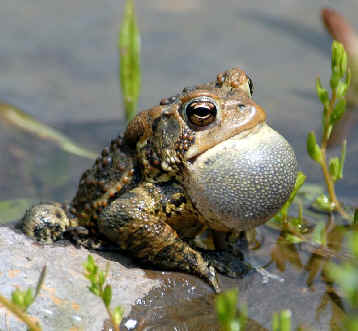
Above & below: American Toads
(upper photo by Howard Eskin; lower photo by Marie Gardner)
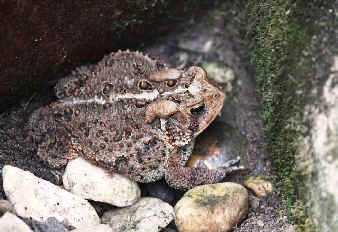
- Oak Toad ______ (*) CNF,NRV
(LE:38) Size: 0.75 to 1.25 inches
Bufo quercicus
The Oak Toad is the smallest of the true toads in North America. It is
abundant in the southeast US, in oak-pine woodlands and upland pine forest
on the coastal plain from Virginia to Louisiana.
It is commonly seen during the day. During dry periods, it burrows into the
ground.
- Southern Toad ______ (*) CNF,NRV
(LE:34) Size: 1.75 to 4 inches
Bufo terrestris
The range of the Southern Toad is on the coastal plain from Virginia to
Louisiana.
- Fowler's Toad (ph) ______ (*)
ARR,NRV (LE:36)
Size: 2 to 3.5 inches
Bufo fowleri
The Fowler's Toad was a subspecies of the more-westerly Woodhouse's Toad,
Bufo woodhousii.
Bufo fowleri breeds mostly from
February through May, but it can be heard in the summer from lakes, ponds,
rivers, ditches, and pools.
The advertisement call of the Fowler's Toad is a buzzy, nasal trill
lasting from 1 to 5 seconds. It sounds somewhat like a baby crying.
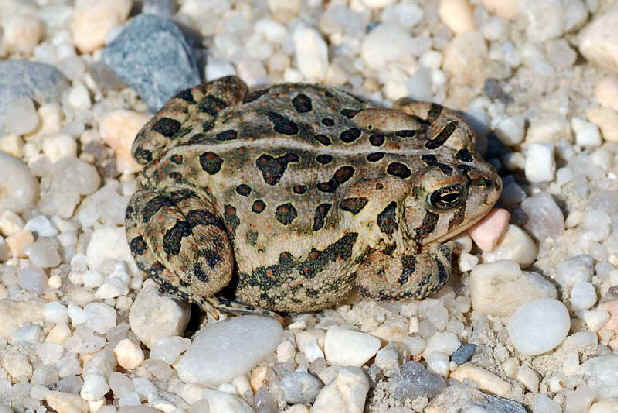
Fowler's Toad
(photo by Howard Eskin)
Family PELOBATIDAE: SPADEFOOTS
- Eastern Spadefoot Toad ______ (*)
ARR,CNF,NRV (LE:39)
Size: 1.75 to 3 inches
Scaphiopus holbrooki
The Eastern Spadefoot Toad was considered a subspecies of the Hurter's
Spadefoot Toad, Scaphiopus hurteri,
of Texas, Oklahoma, Louisiana, and Arkansas.
Scaphiopus holbrooki breeds in
temporary pools caused by heavy rains. It calls during the
summer.
Family MICROHYLIDAE: NARROW-MOUTHED TOADS
- Eastern Narrowmouth Toad ______ (*) ARR,CNF,NRV
(LE:41) Size: 1 to 1.5 inches
Gastrophryne carolinensis
The Eastern Narrowmouth Toad occurs in a variety of habitats, but
in its habits it is secretive.
It breeds in ponds, lakes, pools, and ditches.
SALAMANDERS
Family CRYPTOBRANCHIDAE: GIANT SALAMANDERS
- Eastern Hellbender ______ (in
western North Carolina) (Length: 12 to 29 inches)
Cryptobranchus
alleganiensis alleganiensis
Family PROTEIDAE: MUDPUPPY SALAMANDERS
- Common Mudpuppy ______
(local in western North Carolina) (Length: 8 to 9 inches)
Necturus
maculosus maculosus
- Carolina Mudpuppy ______ (has
been called Neuse River Waterdog) (Length: 6.5 to 11
inches)
Necturus lewisi
The Carolina Mudpuppy is
endemic to North Carolina, in the Neuse and Tar River basins.
Necturus lewisi is classified
as near, or potentially, threatened in North
Carolina.
- Dwarf Mudpuppy ______ (has
been called Dwarf Waterdog) (Length: 4.5 to 7.5
inches)
Necturus
punctatus
- Two-toed Amphiuma ______ NRV
(Length: 18 to 46 inches)
Amphiuma means
- Lesser Siren ______ (Length:
6 to 15 inches)
Siren
intermedia
- Greater Siren ______
(Length: 20 to 37.5 inches)
Siren lacertina
Siren lacertina is classified as near,
or potentially, threatened in North Carolina.
Family AMBYSTOMATIDAE: MOLE SALAMANDERS
- Mabee's Salamander ______ CNF
(northern
limit of range north-east NC) (Length: 3 to 4.5 inches)
Ambystoma mabeei
- Spotted Salamander ______ NRV
(Length: 6 to 10 inches)
Ambystoma maculatum
- Marbled Salamander ______ NRV
(Length: 3.5 to 5 inches)
Ambystoma opacum
- Mole Salamander ______ (mostly
in western North Carolina) (Length: 3 to 5 inches)
Ambystoma talpoideum
- Eastern Tiger Salamander ______
(Length: 7 to 11 inches)
Ambystoma
tigrinum tigrinum
Family PLETHODONTIDAE:
LUNGLESS SALAMANDERS
- Northern Dusky Salamander
______ (Length: 2.5 to 5.5 inches)
Desmognathus fuscus fuscus
- Southern Dusky Salamander ______ ARR
(Length: 3 to 6.5 inches)
Desmognathus auriculatus
- Santeetiah Dusky
Salamander ______ (in far-western North Carolina)
Desmognathus santeetiah
- Appalachian Seal
Salamander ______ (Length: 3 to 6 inches)
Desmognathus monticola monticola
- Black-bellied
Salamander ______ (in western North Carolina)
(Length: 4 to 8 inches)
Desmognathus quadramaculatus
- Mountain Dusky
Salamander ______ (in western North Carolina) (Length:
nearly 3 to 4.5 inches)
Desmognathus ochrophaeus
Desmognathus ochrophaeus has an amazing variation in color, markings, body
proportions, and size. the variation is individual, ontogenetic, and
geographic.
- Imatator
Salamander ______ (in far-western North Carolina)
Desmognathus imitator
Desmognathus imitator is a cryptic species that resembles Desmognathus
ochrophaeus in size and general appearance but differs in genetic
makeup.
Many populations of Desmognathus imitator vary markedly in color and
pattern and can be distinguished from Desmognathus ochrophaeus only
be electrophoretic analysis.
Presently, only certain populations along the main ridge of the Great Smoky
Mountains can be distinguished from Desmognathus ochropheus by their
color patterns.
- Apalachicola Dusky Salamander ______
Desmognathus
apalchicolae
- Pigmy Salamander ______ (in
western North Carolina) (Length: 1.5 to 2 inches)
Desmognathus
wrighti
- Seepage Salamander
______ (another name is Cherokee Salamander)
(in far-western
North Carolina) (Length: 1.75 to 2.25 inches)
Desmognathus aeneus
- Shovelnose Salamander ______
(in western North Carolina) (Length: 3.5 to 5.5 inches)
Desmognathus
(or Leurognathus) marmoratus
- Northern Two-lined Salamander
______ (Length: 2.5 to 5 inches)
Eurycea
bislineata bislineata
- Southern Two-lined Salamander
______
Eurycea cirrigera
- Blue Ridge Two-lined Salamander
______
Eurycea wilderae
- Junaluska Salamander (t3)
______ (in far-west North
Carolina) (Species described in 1976) (Length: 3 to 4 inches)
Eurycea
junaluska
Eurycea juniuska is known only to
be in Graham County, North Carolina, and the western tip of the Great Smoky
Moutnains Park.
- Long-tailed Salamander ______ (Length:
3.5 to 8 inches)
Eurycea
longicauda longicauda ______
(locally in western North Carolina)
Eurycea longicauda guttolineata Three-lined Salamander ______
- Dwarf Salamander ______
(Length: 2 to 3.5 inches)
Eurycea quadridigitata
- Eastern Red-backed Salamander
______ (has been called Redback Salamander)
(Length: 2.25 to 5 inches)
Plethodon cinereus
- Southern Red-backed Salamander
______ (in far-western North Carolina) (Length: 2.25
to 5 inches)
Plethodon
serratus
- Ravine Salamander ______ (in
western North Carolina) (Length: 3 to 5.5 inches)
Plethodon
richmondi
- Weller's Salamander ______ (in
far-western North Carolina) (Length: 2.5 to 3 inches)
Plethodon
welleri
- Wehrle's Salamander ______ (local
in North Carolina) (Length: 4 to 6.5 inches)
Plethodon
wehrlei
- Northern Slimy Salamander ______ NRV
(Length: 4.5 to 8 inches)
Plethodon glutinous glutinsus
- Yonahlossee Salamander ______
(in western North Carolina) (Length: 4.5 to 7.5 inches)
Plethodon
yonahlossee
- Jordan's Salamander ______
(in western North Carolina) (Length: 3.5 to 7 inches)
Plethodon
jordani
- Northern Zigzag Salamander
______ (Length: 2.5 to 4.5 inches)
Plethodon
dorsalis
In North Carolina, Plethodon
dorsalis is only known to occur in Henderson County.
It seems as if the known
populations of Plethedon dorsalis are relicts of a widespread
Pleistocene population.
- Four-toed Salamander ______ (Length:
2 to 3.5 inches)
Hemidactylium
scutatum
- Many-lined Salamander ______
(in eastern North Carolina) (Length: 2.5 to 4.5 inches)
Stereochilus
marginatus
- Green Salamander ______ (in
far-western North Carolina) (Length: 3 to 5.5 inches)
Aneides aeneus
- Spring Salamander ______ (Length:
nearly 4.5 to 8.5 inches)
Gyrinophilus
porphyriticus danielsi Blue
Ridge Spring Salamander
______
Gyrinophilus porphyriticus dunni Carolina
Spring Salamander
______
- Eastern Mud Salamander ______
(Length: 3 to 7.5 inches)
Pseudotriton montanus montanus
- Red Salamander ______ (Length: 3
to 7 inches)
Pseudotriton ruber riber Northern Red Salamander
______
Pseudotriton ruber schencki Blackchin Red Salamander
______
Family SALAMANIDRIDAE: NEWTS
- Eastern Newt ______ (Length: 2.5
to 5.5 inches)
Notophthalmus viridescens virdescens
Red-spotted Newt ______
Notophthalmus viridescens dorsalis Broken-striped Newt
______
Reptiles:
ALLIGATOR
Family ALLIGATORIDAE
- American Alligator (ph) ______ (*) ARR
(in eastern North Carolina) (Length: 6 to 19 feet)
Alligator mississippiensis
The American Alligator is classified as endangered on
North Carolina.
TURTLES
Family CHELYDRIDAE
- Snapping Turtle (ph) ______ (*)
NRV (Length: 8 to 18.5 inches)
Chleydra serpentina

Snapping Turtle
(photo by Howard Eskin)
Family KINOSTERNIDAE: MUSK & MUD TURTLES
- Eastern Mud Turtle ______ (*) ARR,NRV
(Length: 3 to 5 inches)
Kinosternum subrubum subrubum
- Eastern (or Common) Musk Turtle
______ (*) NRV (another name
is Stinkpot) (Length: 3 to 5.5
inches)
Sternotherus odoratus
- Stripeneck Musk Turtle ______ (in far-western North Carolina) (Length: 3 to 4.5 inches)
Sternotherus minor pelifer
Family EMYDIDAE: BOX, POND, and MARSH TURTLES
- Eastern Box Turtle (ph) ______ (*)
ARR,CNF,NRV (Length: 4.5 to 6.5 inches)
Terrapene carolina carolina
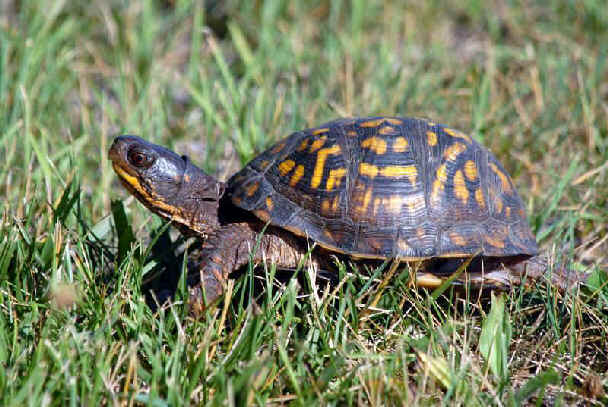
Above & below: Eastern Box Turtles
(upper photo by Howard Eskin; lower photo by Rise Hill)
In the lower photo, the turtle crossing a
road.

- Eastern River Cooter ______ (*) NRV
(Length: 5.5 to 12.5 inches)
Pseudemys
(formerly Chrysemys) concinna
- Northern Red-bellied Cooter (ph) ______
(*)
(has also been called Redbelly Turtle) (in eastern
North Carolina) (Length: 10 to 16 inches)
Pseudemys rubriventris
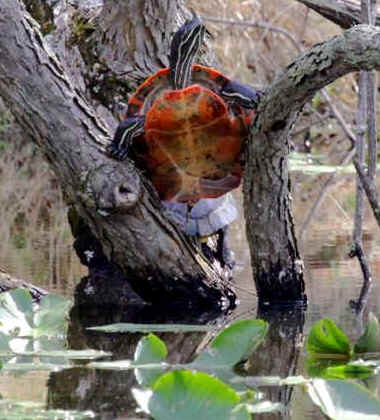
Above & below: Northern Red-bellied Cooters
(upper photo by Marie Gardner; lower photo by
Howard Eskin)
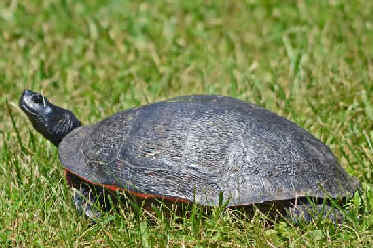
- Florida
(or Peninsular) Cooter ______ (Length: 9 to 15.5 inches)
Pseudemys floridana
- Eastern Painted Turtle (ph) ______ (*)
ARR,NRV (Length: 4.5 to 7 inches)
Chrysemys picta picta
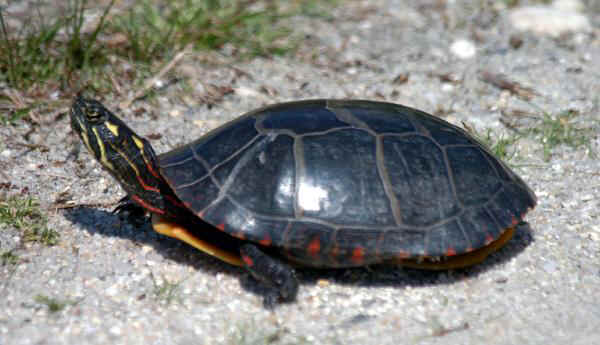
Painted Turtles
(photo by Howard Eskin)
- Yellowbelly
(or Pond) Slider (ph) ______ (*) NRV
(Length: 5 to 11.5 inches)
Chrysemys scripta

The Yellowbelly, or Pond Slider
(photo by Howard Eskin)
- Spotted Turtle ______
NRV (Length: 3.5 to 5 inches)
Clemmys guttata
- Bog Turtle ______ (in western
North Carolina) (Length: 3 to 4 inches)
Clemmys muhlenbergii
- Chicken Turtle ______ (Length:
4 to 10 inches)
Deirochelys reticularis
- Northern Diamondback Terrapin (ph) ______ (*)
OBX (in eastern North Carolina)
(Length: 6 to 9 inches)
Malaclemys terrapin terrapin
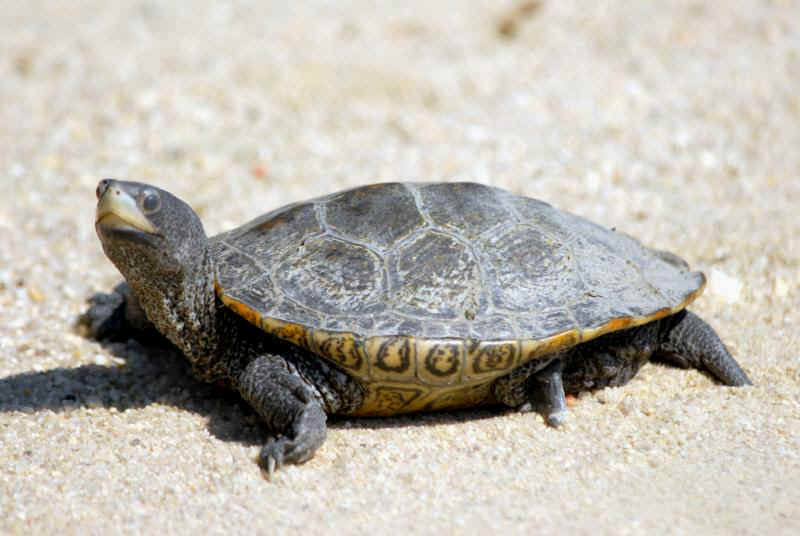
Diamondback Terrapin
(photo by Howard Eskin)
Families DERMOCHELYIDAE and CHELONIIDAE:
SEA TURTLES
An excellent book, filled with good information about Sea Turtles,
and interesting reading, is "Voyage of the Turtle - in Pursuit
of the Earth's Last Dinosaur", by Carl Safina, published in
2007.
- Leatherback (Sea Turtle) (t1) (ph) ______ (*) offshore
ocean (Length: 53 to 70 inches)
Dermochelys coriacea
The Leatherback Sea Turtle is classified as endangered
in North Carolina oceanic waters.
- Loggerhead (Sea Turtle) (t2) (ph) ______ (*) offshore
ocean (Length: 31 to 47 inches)
Caretta caretta
The Loggerhead Sea Turtle nests on a few undisturbed
beaches in North Carolina. It is classified as endangered in the state along
the seacoast and offshore.
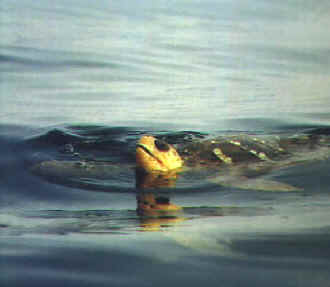
Loggerhead Sea Turtle
(photographed by Alan Brady
during a FONT North Carolina pelagic trip)
- Green Turtle (t2) ______
(Length: 30 to 60 inches)
Chelonia mydas
- Atlantic Hawksbill (t1)
______ (Length: 29.5 to 36 inches)
Eretmochelys imbricata imbricata
- Kemp's Ridley (t1) ______
(Another name is Atlantic Ridley) (Length: 23 to 30 inches)
Lepidochelys kempii
Family TRIONYCHIDAE: SOFTSHELLS
- Spiny Softshell (ph)
______ (Length: 5 to 9 inches)
Apalone (formerly Trionyx) spinifera
Apalone spinifera spinifera Eastern Spiny Softshell
______
Apalone spinifera aspera Gulf Coast Shiny Softshell
______
LIZARDS
Family POLYCHRIDAE
- Carolina Anole ______ (*)
CNF,NRV (also called Green
Anole)
(Length: 5 to 8 inches)
Anolis carolinensis
Family PHRYNOSOMATIDAE
- Northern Fence Lizard ______ (*)
CNF,NRV (Length: 4 to 7.3 inches)
Scelopus undulatus hyacinthinus
Family SCINCIDAE: SKINKS
- Common Five-lined Skink ______ NRV
(Length: 5 to 8 inches)
Eumeces fasciatus
- Southeastern Five-lined Skink ______ NRV
(Length: 5.5 to 8.5 inches)
Eumeces inexpectatus
- Broadhead Skink ______ NRV
(Length: 6.5 to 13 inches)
Eumeces laticeps
- Northern Coal Skink ______ (Length: 5 to 7 inches)
Eumeces anthracinus
anthracinus
- Little Brown Skink ______ NRV
(Another name is Ground Skink) (Length: 3 to 5 inches)
Scincella lateralis
(formerly Leiolopisma laterale)
Family TEIIDAE
- Six-lined Racerunner ______ NRV
(conspecific
with the more-westerly Prairie Racerunner) (Length: 6 to 9.5 inches)
Cnemidophorus sexlineatus sexlineatus
Family ANGUIDAE
- Slender Glass Lizard ______ (Length:
22 to 46.5 inches)
Ophisaurus attenuatus
- Eastern Glass Lizard ______ (*) ARR
(Length: 18 to 42 inches)
Ophisaurus ventralis
- Mimic Glass Lizard
______
Ophisaurus mimicus
SNAKES
Family COLUBRIDAE: COLUBRID SNAKES
- Eastern Worm Snake ______ NRV
(Length: 7.5 to 12.5 inches)
Carphophis amoenus amoenus
- Northern Scarlet Snake ______ (Length: 14 to 26 inches)
Cemophora coccinea copei
- Northern Black Racer ______ (*) ARR,NRV
(Length: 36 to 56 inches)
Coluber constrictor constrictor
As the English name implies, the Black Racer is a fast-moving snake, but
contrary to the scientific name (constrictor), it does not use constriction
to subdue its prey.
- Southern Ringneck Snake ______ (Length: 10 to 20 inches)
Diadophis punctatus punctatus
- Corn Snake ______ CNF
(Length: 30 to
72 inches)
Elaphe guttata
The Corn Snake can be confused with several other snakes, notably the Milk
Snake, the Black Rat Snake, and the Copperhead.
- Rat Snake ______ NRV
(Length: 42 to
85 inches)
Elaphe obseleta
Elaphe obseleta obseleta Black Rat Snake ______
Elaphe obseleta quadrivitata Yellow Rat Snake ______
(in
southern North Carolina)
- Eastern Mud Snake ______ ARR,CNF,NRV
(Length: 40 to 73 inches)
Farancia abacura abacura
- Rainbow Snake ______ ARR
(Length: 36
to 66 inches)
Farancia erytrogramma
- Eastern Hognose Snake ______ NRV
(nicknames have included "Puff Adder",
"Hissing Adder", "Spreading
Adder") (Length: 20 to 47 inches)
Heterodon platyrhinos
Heterodon platyrhinos is typically found in sandy habitats, occurring in
fields, dunes, and on beaches.
Heterodon platyrhinos has the formidable-sounding nicknames noted above from
a behavior that it has of scaring off would-be attackers.
When disturbed, the Hognose Snake widens its neck to take on a hood-like
appearance. It does so by flattening the head and neck, spreading long
rib-bones outward. Then, inflating the body with air, hissing and striking
out, it suddenly resembles a fearsome-looking creature. But it is harmless,
and if awards in various categories were given to snakes, Heterodon
platyrhinos would win hands-down for "most dramatic
performance".
- Southern Hognose Snake ______ CNF
(the northern
limit of its range is in south-central North Carolina) (Length: 13
to 22 inches)
Heterodon simus
- Mole Kingsnake ______
(Length: 30 to 46 inches)
Lampropeltis calligaster rhombomaculata
- Kingsnake ______ NRV
(Length: 36 to 69 inches)
Lampropeltis getulus
Lampropeltis getulus getulus Eastern Kingsnake ______
Lampropeltis getulus sticticeps Outer Banks Kingsnake ______
- Scarlet Kingsnake, Eastern Milk Snake ______
(Length: 24 to 45 inches)
These 2 forms, that appear so
different from each other, were long thought to be 2 species, but are actually
conspecific. There's a zone of intergradation, with snakes having
intermediate characteristics, in northeastern North Carolina.
Lampropeltis triangulum
Lampropeltis triangulum triangulum Eastern Milk Snake
______ (in western North Carolina)
Lampropeltis triangulum elapsoides Scarlet Kingsnake
______
- Eastern Coachwhip ______ CNF
(Length:
48 to 94 inches)
Masticophis flagellum flagellum
The Eastern Coachwhip is probably the longest snake in North Carolina.
- Red-bellied Water Snake ______ ARR,NRV
(Length: 30 to 60 inches)
Nerodia erythrogaster
- Banded Water Snake ______ ARR,NRV
(Length: 24 to 55 inches)
Nerodia fasciata fasciata
- Brown Water Snake ______ NRV
(Length:
32 to 64 inches)
Nerodia taxispilota
- Common Water Snake (ph) ______
ARR (Length: 24 to 50 inches)
Nerodia sipedon pleuralis Midland Water Snake
______
The Common Water Snake is a common resident of swamps, marshes, bogs,
streams, and pond and lake borders.
Quiet waters are preferred, but it can occur by swift-flowing streams and in
the environs of waterfalls. It can be in any of these wet places where it
has not been exterminated by people or pollution.
- Florida Green Water Snake ______
Nerodia floridana
- Rough Green Snake ______ NRV
(Length:
22 to 36 inches)
Opheodrys aestivus
- Glossy Crayfish Snake ______ (Length:
14 to 30.5 inches)
Regina rigida
- Queen Snake ______ (in western
North Carolina) (Length: 15 to 34 inches)
Regina
(formerly Natrix) septemvittata
Regina septemvittata
is rarely found far from the water's edge. Its
principal food has been said to be crayfish that have already molted.
- Pine Woods Snake ______ CNF
(Length:
10 to 15 inches)
Rhadinaea flavilata
- Black Swamp Snake ______ ARR
(Length:
10 to 19 inches)
Seminatrix pygaea
- Northern Brown Snake ______ NRV
(Length: 9 to 18 inches)
Storeia dekayi dekayi
- Red-bellied Snake ______ (Length: 6.5
to 12 inches)
Storeria occipitomaculata
- Southestern Crowned Snake ______ CNF
(Length: 8 to 12 inches)
Tantilla coronata
- Eastern Garter Snake (ph) ______
NRV (Length: 18 to 42 inches)
Thamnophis sirtalis sirtalis
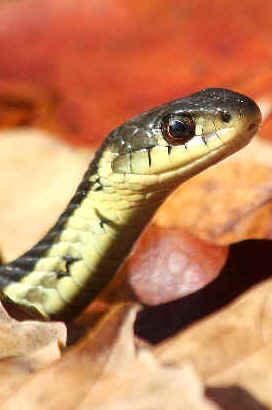

Two photographs of the Eastern Garter Snake
(above photo by Doris Potter; lower photo by Howard Eskin)
- Eastern Ribbon Snake ______ NRV
(Length: 18 to 38 inches)
Thamnophis sauritus sauritus
- Rough Earth Snake ______ (Length: 7
to 12.5 inches)
Virginia striatula
- Smooth Earth Snake ______ (Length: 7
to 13 inches)
Virginia valeriae
Family ELAPIDAE
- Eastern Coral
Snake ______ (venomous)
(in southern North Carolina)
Micrurus fulvius fulvius
Family VIPERIDAE
- Copperhead ______ ARR,CNF,NRV
(venomous) (Length: 24 to 45 inches)
Agkistrodon contortrix
Agkistrodon contortrix mokasen Northern Copperhead ______
Agkistrodon contortrix contortrix Southern Copperhead ______
Intergrades of the Northern and Southern Copperheads are often
lighter-colored (sometimes pinkish) and have narrower crossbands, thus
causing some confusion with some nonvenomous snakes with boldly-patterned
backs such as the Corn Snake, Eastern Hognose Snake, and Milk
Snake,
- Eastern Cottonmouth (ph) ______ (*)
ARR,CNF,NRV (venomous)
(Length: 30 to 71 inches)
Agkistrodon piscivorus piscivorus
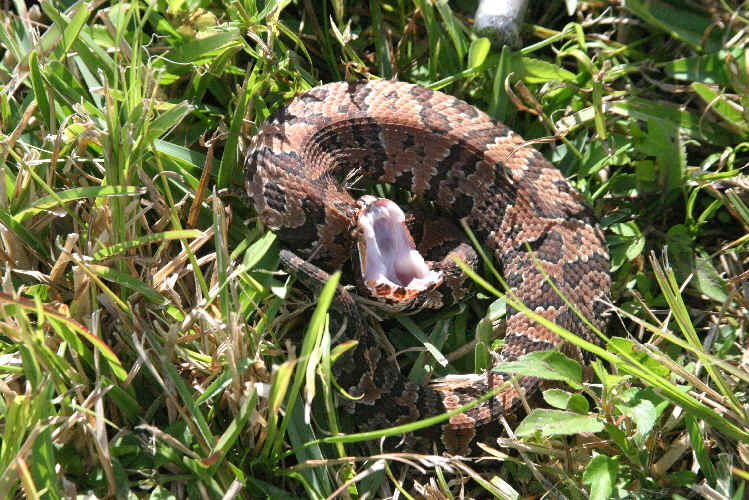
Eastern Cottonmouth
(photo courtesy of Michael Christopher)
- Eastern Diamondback Rattlesnake ______
(venomous)
(Length: 42 to 78 inches)
Crotalus adamanteus
The Eastern Diamondback Rattlesnake
is classified as endangered in North Carolina.
- Timber Rattlesnake (ph)
______
(venomous)
(Length: 36 to 72 inches)
Crotalus horridus
In the Carolinas, Crotalus horridus
is called the "Canebrake Rattlesnake".
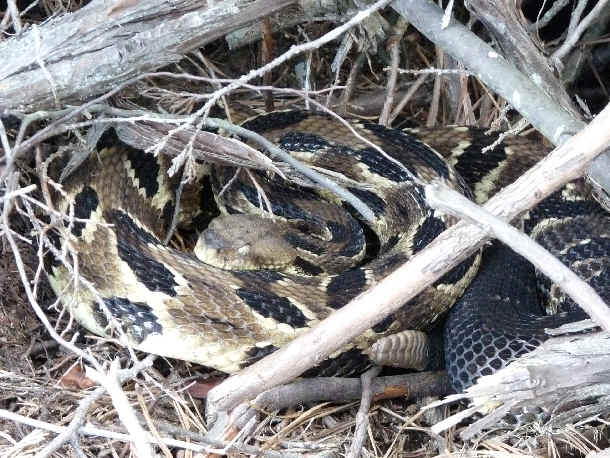
Timber Rattlesnake
(photo by Fred Lesser)
- Carolina Pygmy Rattlesnake
______ CNF
(venonmous)
(Length:15 to 26 inches)
Sistrurus miliarius miliarius
A reference book regarding North Carolina Amphibians & Reptiles:
"Amphibians & Reptiles of the Carolinas
and Virginia", by Bernard Martof, William Palmer, Joseph Bailey, &
Julian Harrison III, with photographs by Jack Dermid, 1980


 Amphibians
and Reptiles
Amphibians
and Reptiles 




















